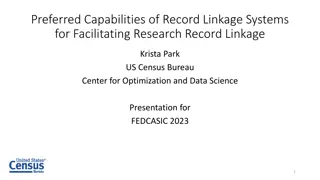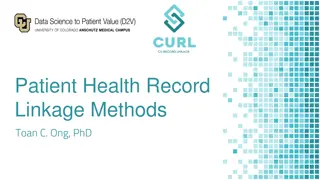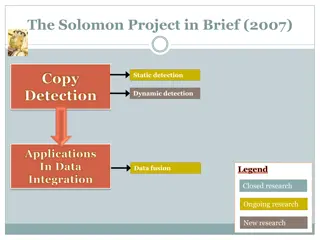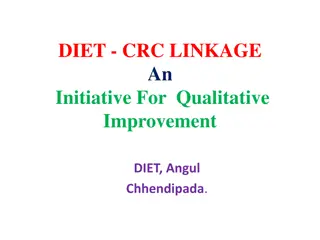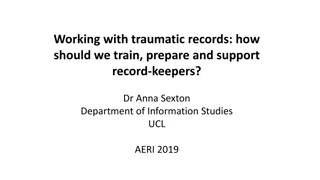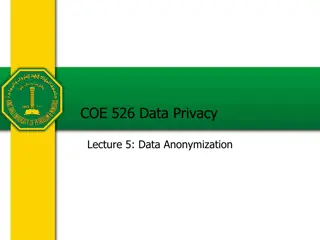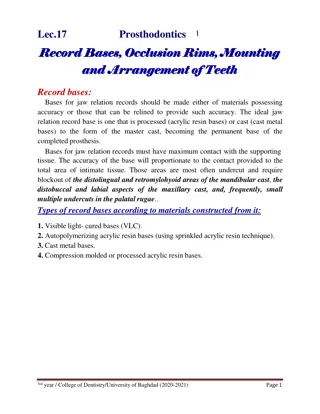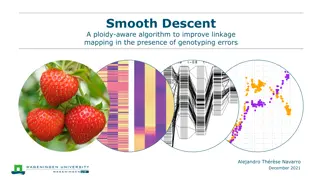Record Linkage Concepts
Explore the fundamentals of record linkage, also known as matching or merging, which involves combining data from different sources for the same individual. Learn about the importance of efficient and accurate duplicate detection, deterministic matching, and the challenges of variations in data between files. Discover how technological advancements enable computerized record linkage for large datasets.
Download Presentation

Please find below an Image/Link to download the presentation.
The content on the website is provided AS IS for your information and personal use only. It may not be sold, licensed, or shared on other websites without obtaining consent from the author.If you encounter any issues during the download, it is possible that the publisher has removed the file from their server.
You are allowed to download the files provided on this website for personal or commercial use, subject to the condition that they are used lawfully. All files are the property of their respective owners.
The content on the website is provided AS IS for your information and personal use only. It may not be sold, licensed, or shared on other websites without obtaining consent from the author.
E N D
Presentation Transcript
Record Linkage Concepts
Acknowledgements Slides adapted from training materials developed by CDC NPCR Faculty: Melissa Jim, CDC/IHS melissa.jim@ihs.gov David Espey, CDC/IHS david.espey@ihs.gov CDC/Link Plus development and training: Kathleen Thoburn David Gu Adapted by: Megan Hoopes, NW Tribal Epidemiology Center mhoopes@npaihb.org
Overview of Record Linkage Record Linkage aka Matching aka Merge Combining information from a variety of data sources for the same individual Merge information from a record in one data source (file 1) with information from another data source (file 2) Example: merging cancer information from cancer registry file with death information from vital statistics file
Overview of Record Linkage Can be accomplished manually, by visually comparing records from two separate sources Approach becomes time consuming, tedious, inefficient, and unpractical as the number of records in file 1 and file 2 increases Technological advances in computer systems and programming techniques Economically feasible to perform computerized record linkage between large files Efficient and relatively accurate
Duplicate Detection Fundamental requirement for accuracy and validity of counts in any disease registry Example: National Program of Cancer Registries/ North American Association of Central Cancer Registries standard Maintain <= 0.1% (<=1 per 1,000) duplicates
Deterministic Matching Computerized comparison where EVERYTHING needs to match EXACTLY: Last Name First Name Site SSN DOB Sex DateDx SMITH JOHN C619 123654789 02011934 1 06152004 SMITH JOHN C619 123456789 02011934 1 06152004
Deterministic Matching Often slight variations exist in the data between the two files for the same variables: Last Name First Name Site SSN DOB Sex DateDx SMITH JOHN C619 123456789 02011934 1 06152004 SMYTH JOHN C619 123456786 02081934 1 06102004 Or variables are missing from one of the files: Last Name First Name Site SSN DOB Sex DateDx SMITH JOHN C619 123654789 02011934 1 06152004 SMITH JOHN C619 02011934 1 06152004 These variations would prevent a match from being identified
Deterministic Matching Manual Review When we manually review, we use intuition to help us identify positive matches for records containing slight variations in, or missing information for, data between the two files for the same variables Last name First Name Site SSN DOB Sex DateDx SMITH JOHN C619 123456789 02011934 1 06152004 SMITH JOHN C619 123456786 02101934 1 06152004 Typo in SSN, transposition of digits in the day component of DOB, but would still deem a match
Probabilistic Matching Translating intuition into formal decision rules Use the concept of PROBABILITY and perform PROBABILISTIC matching Recommended over traditional deterministic (exact matching) methods when: coding errors, reporting variations, missing data or duplicate records Estimate probability/likelihood that two records are for the same person versus not
Probabilistic Matching Find the records in File 2 that seem to match records in File 1 Calculate a score that indicates, for any pair of records, how likely it is that they both refer to the same person Sort the likely and possible matched pairs in order of their scores Define a threshold (Cut Off values) for automatically accepting and rejecting a potential link Discard unlikely matched pairs (scores below 2nd Cut Off) Gray area: range of scores between the two cut off values considered uncertain matches Manually review uncertain matches
Probabilistic Matching The total score for a linkage between any two records is the sum of the scores generated from matching individual fields The score assigned to a matching of individual fields is: Based on the probability that a matching variable agrees given that a comparison pair is a match M Probability - similar to "sensitivity Reduced by the probability that a matching variable agrees given that a comparison pair is not a match U Probability - similar to "specificity"
Probabilistic Matching Agreement argues for linkage Disagreement argues against linkage Full agreement argues more strongly for linkage than partial agreement Some types of partial agreements are stronger than others Rare surname versus residence county code
Probabilistic Matching Agreement on an uncommon value argues more strongly for linkage than a common value Espey versus Smith Agreement on a more specific variable argues more strongly for linkage than agreement on a less specific one SSN versus Sex Agreement on more variables/disagreement on few argues for linkage
Probabilistic Matching Once comparisons are made, a weight is calculated for each field comparison A total weight (or score ) is derived by summing these separate field comparisons across all fields being compared Probabilistic weights are Field-specific Birth date versus Sex Value-specific - Jane versus Janiqua
Linkage basics Blocking variables Matching variables Advantages of Link Plus Using Link Plus
Concept of Blocking With so many comparisons, large files can make impossible resource demands Blocking is an initial probabilistic linkage step that reduces the number of record comparisons between files Sort and match the two files by one or more identifying ( blocking ) variables Comparisons subsequently made only within blocks Discard very unlikely record-pairings from the start
Sorting socks analogy Blocking variable: Pattern 6 of 13 socks within pattern block compare matching variables 7 of 13 socks fall outside pattern block Non-matches
Compare matching variables color & size within blocked pairs High Score Possible matches Gray Area Low Score
Probabilistic linkage concepts (1) Description An initial step to reduce the number of record comparisons and increase efficiency of linkage. At least one blocking variable must match exactly (or phonetically) between the two records being compared; subsequent comparisons are made after blocking. Common usage* Blocking variables: Last name First name Social security number Date of birth Matching variables: Last name First name Social Security Number Date of Birth Sex Address The user may designate matching algorithms & M-probabilities for each variable. Blocking After blocking, matching variables are compared to generate a match score for each record pair. Match scores for each variable are: Field-specific (matching DOB is scored higher than matching sex) Value-specific (last name of Hoopes is scored higher than Smith due to frequency of occurrence) Matching * May vary based on data items and quality of data in available in matching data sets
Probabilistic linkage concepts (2) Description Common usage* The total probability weight assigned to each record pair; equal to the sum of scores generated by comparing each match field. Based on software-calculated M probability (sensitivity) and U probability (specificity). The range of match scores is examined to determine upper and lower cut-off values. High match scores are likely true matches and scores below cut-off value are automatically designated false matches. Record pairs between cut-off values are clerically reviewed. Match score Case-by-case review of uncertain matches that fall between the upper and lower cut- off values. Additional variables can be added to record layout to assist in the designation of match status. This process can be completed independently by two or more reviewers to increase reliability. Additional variables may include: Street address City, state, zip code Suffix Race/ethnicity Maiden name Clerical review * May vary based on data items and quality of data in available in matching data sets





